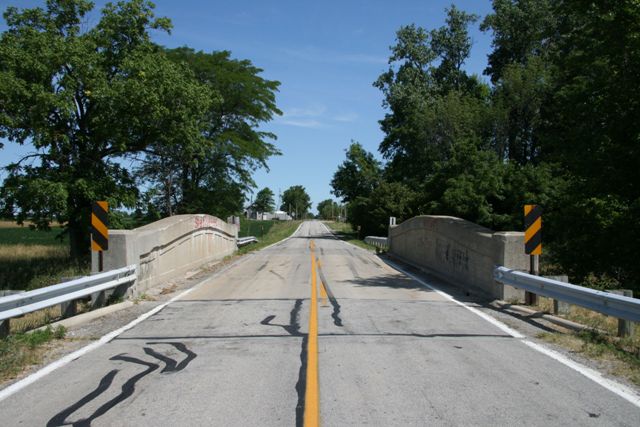We Recommend:
Bach Steel - Experts at historic truss bridge restoration.
Fulton Lucas Road Bridge

Primary Photographer(s): Rick McOmber
Bridge Documented: July 15, 2007
Rural: Fulton County, Ohio and Lucas County, Ohio: United States
1980
56.0 Feet (17.1 Meters)
59.0 Feet (18 Meters)
23.3 Feet (7.1 Meters)
1 Main Span(s)
4830768

View Information About HSR Ratings
Bridge Documentation
View Archived National Bridge Inventory Report - Has Additional Details and Evaluation
Although their appearance is quite different, this bridge functionally appears to be based on the ideas behind the unique concrete curved chord through girder bridges designed and built in Michigan. The design was simple, yet it was not known to be built widely outside of Michigan's borders. Ohio has a small number of remaining concrete curved chord girders, however and each remaining example should be considered historically significant. The design essentially consisted of taking the standard concrete girder bridge and adding an arch shape to the girders. This was likely done to increase strength, improve efficient use of materials, and enhance the physical appearance of the structure. Ohio did not build as many of the unusual curved chord through girder design Most of Ohio's concrete curved chord through girders do not appear to be larger than 60 feet, and many appear to be right at that sixty foot length.
This bridge is an example of the most common Ohio design, with distinct end posts, a smooth curve, and inset rectangles on the girder face.
HistoricBridges.org disagrees with not only the Not Eligible finding of the Historic Bridge Inventory, but also the philosophy upon which that decision was based. Ohio's Historic Bridge Inventory basically wrote every single curved chord through girder off as Not Eligible, failing to list even large, early, or unaltered examples as significant. The reason given for this was apparently because the bridges did not contribute to the development of bridges in Ohio. However, HistoricBridges.org still believes the bridges are important in the context of Ohio bridge history because they document the fact that the development of bridge design was not perfect, and in some cases, bridge types were proliferated throughout the state before engineers ultimately decided that they were not the best type of bridge to be building. Also, the inventory makes the comment that the curved aspect of the girder is "not aesthetic." While certainly, the curve of the girder serves an engineering purpose, it actually does also serve an aesthetic purpose, since curves are an aesthetic element in bridge design. A separation of aesthetic and structural purpose may be required in modern bridges, where aesthetics are (if present at all) are confined to superficial decorations on the bridge. However, with historic bridges like this one, aesthetics and structural function were not exclusive. Engineers developed aesthetics that were not superficial but were instead functional parts of the bridge structure. This bridge is an example of this technique.
Information and Findings From Ohio's Historic Bridge InventorySetting/Context The bridge carries a 2 lane road over a stream in a rural area of active farms. Physical Description The 1-span, 59'-long, reinforced-concrete thru girder bridge has paneled, shaped girders with blocky end posts and articulated floorbeams. It is supported on concrete abutments. Integrity Alterations in 1980 unspecified and not apparent from photos. Summary of Significance The 1928 thru girder bridge is a late and undistinguished example of a standardized bridge type in use from the mid 1910s to 1930s. It is not technologically significant. Reinforced-concrete thru girder bridges
are composed of a pair of cast-in-place longitudinal girders and transverse floorbeams or deck slab (the former is the case with most Ohio examples) that are connected by the arrangement of the steel reinforcing bars. The roadway
passes between the paired girders, which are the main supporting members and also serve as railings. The girders are commonly very large in appearance (18" to 30" wide and 4' to 6' deep) and have deep panels to save on weight. The
depth of the girders is related to span length with the longer the span the greater the depth. In many cases, the girders are shaped to achieve the greatest depth of beam at mid-span where it is required to support the design
moments (stresses). The shaped girder is a design detail to accommodate longer and/or wider spans and/or heavier design loads, it is not aesthetic. Bridge Considered Historic By Survey: No |
![]()
Photo Galleries and Videos: Fulton Lucas Road Bridge
Bridge Photo-Documentation
Original / Full Size PhotosA collection of overview and detail photos. This gallery offers photos in the highest available resolution and file size in a touch-friendly popup viewer.
Alternatively, Browse Without Using Viewer
![]()
Bridge Photo-Documentation
Mobile Optimized PhotosA collection of overview and detail photos. This gallery features data-friendly, fast-loading photos in a touch-friendly popup viewer.
Alternatively, Browse Without Using Viewer
![]()
Maps and Links: Fulton Lucas Road Bridge
Coordinates (Latitude, Longitude):
Search For Additional Bridge Listings:
Bridgehunter.com: View listed bridges within 0.5 miles (0.8 kilometers) of this bridge.
Bridgehunter.com: View listed bridges within 10 miles (16 kilometers) of this bridge.
Additional Maps:
Google Streetview (If Available)
GeoHack (Additional Links and Coordinates)
Apple Maps (Via DuckDuckGo Search)
Apple Maps (Apple devices only)
Android: Open Location In Your Map or GPS App
Flickr Gallery (Find Nearby Photos)
Wikimedia Commons (Find Nearby Photos)
Directions Via Sygic For Android
Directions Via Sygic For iOS and Android Dolphin Browser
USGS National Map (United States Only)
Historical USGS Topo Maps (United States Only)
Historic Aerials (United States Only)
CalTopo Maps (United States Only)

